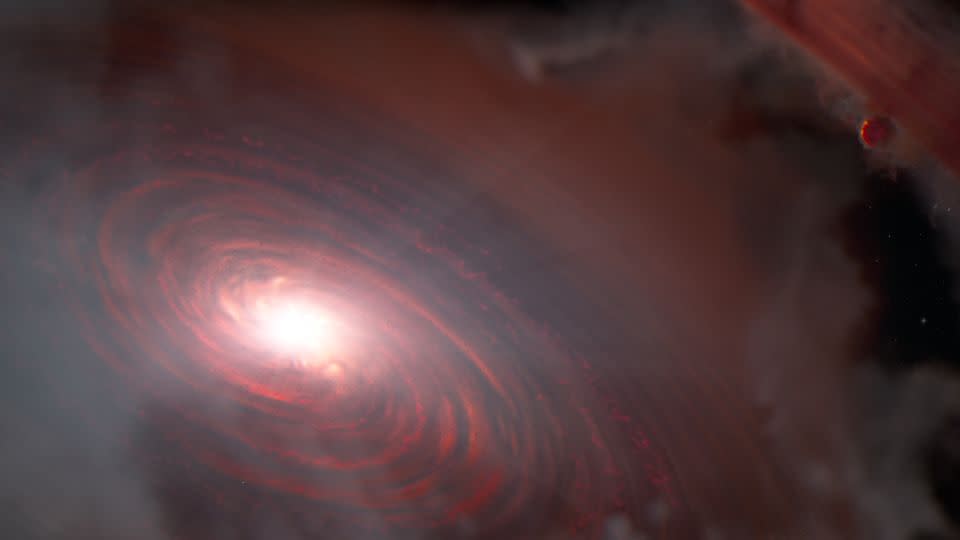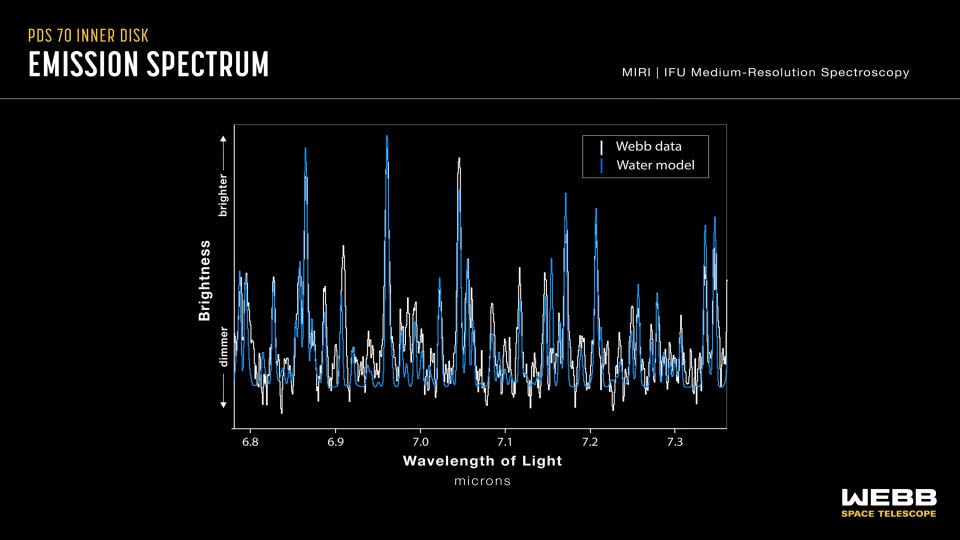Webb telescope spots water in a nearby planetary system
Editor’s note: Sign up for CNN’s Wonder Theory science newsletter. Explore the universe with news on fascinating discoveries, scientific advancements and more.
Astronomers have detected water vapor swirling close to a nearby star — indicating that the planets forming around it might someday be able to support life.
The young planetary system, known as PDS 70, is 370 light-years away. The star at its center is about 5.4 million years old and cooler than our sun. Circling it are two known gas giant planets, and researchers recently determined that one of them, PDS 70b, may share its orbit with a third “sibling” planet that is forming there.
Two different disks of gas and dust — the ingredients necessary to form both stars and planets — surround the star. The inner and outer disks are separated by a gap spanning 5 billion miles (8 billion kilometers). The gas giants are in the gap, where they orbit the star.

The Webb telescope’s Mid-Infrared Instrument detected the signature of water vapor in the inner disk, less than 100 million miles (160 million kilometers) from the star. Astronomers believe that inner disk is where small, rocky planets similar to those in our solar system could form if PDS 70 is anything like our solar system. In our system, Earth orbits at a distance of 93 million miles (150 million kilometers) from the sun.
A study detailing the findings published Monday in the journal Nature.
“We’ve seen water in other disks, but not so close in and in a system where planets are currently assembling. We couldn’t make this type of measurement before Webb,” said lead study author Giulia Perotti, a postdoctoral fellow at the Max Planck Institute for Astronomy in Heidelberg, Germany, in a statement. PDS 70 is relatively old for a star that hosts a planet-forming disk.
Water vapor mystery
Astronomers were surprised to discover water vapor near the star given its age. PDS 70 is relatively old for a star that hosts a planet-forming disk.
The amount of gas and dust in these disks decline over time due to the activity of the star, or because the material clumps together to form planets. Water hasn’t been spotted in a planet-forming disk of this age before, which led astronomers to believe that water vapor couldn’t survive stellar radiation for such long periods and that any rocky planets forming there would be dry.
No planets have been found forming in the inner disk, but all the ingredients necessary have been detected. The presence of water vapor suggests the planets could contain water in some form. Only time will tell whether the planets form — and if they are potentially habitable for life.

“We find a relatively high amount of small dust grains. Combined with our detection of water vapor, the inner disk is a very exciting place,” said study coauthor Rens Waters, professor of astrophysics at Radboud University in the Netherlands, in a statement.
But where did the water vapor originate?
It’s possible that hydrogen and oxygen atoms combine to form water molecules within the inner disk, or that icy dust particles are moving from the cooler outer disk to the hot inner disk, causing the ice to become vapor.
The water vapor has likely remained stable despite its proximity to the star because the dust protects it from being broken apart by the star’s ultraviolet radiation. The research team plans to observe the system with Webb more in the future to reveal additional secrets as a planetary system takes shape.
“This discovery is extremely exciting, as it probes the region where rocky planets similar to Earth typically form,” said study coauthor Thomas Henning, Max Planck Institute for Astronomy director and coprincipal investigator of Webb’s Mid-Infrared Instrument, in a statement.
For more CNN news and newsletters create an account at CNN.com

